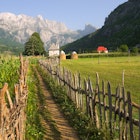

Newer aircraft reduce emissions © Thomas Jackson / Getty Images
COVID-19 will forever change travel – and the way we travel. As the world navigates the coronavirus crisis, how can we prepare ourselves for the climate crisis that is right behind it? Aviation journalist John Walton does some thinking about how we can all travel greener and more sustainably.
Once the COVID-19 lockdowns, quarantines and restrictions end, I know I’m absolutely raring to start traveling again. But one of the things that many of us are coming to realise is just how fragile the world we love to explore is, and how important it is to be good stewards of it while we do so.
There’s a whole industry out there for ecologically friendly holidays, and that’s great. But beyond the eco-yurt – although we do love a good eco-yurt – there are choices that we can all make to reduce our contributions to climate change when we start traveling again.

Newer aircraft with lower emissions
For most travelers flying to their destination, the airline journey will be the largest part of their environmental footprint. That’s not just because of the emissions produced, but also because they’re released at higher altitudes, which amplifies their effect.
Newer aircraft like the Airbus A350, A320neo or A220, or the Boeing 787, have an emissions footprint about a quarter lower than the jets they replace. With COVID-19’s drop in the demand for travel, many of those older aircraft have been retired and won’t return to the skies, and we’ll be flying on those newer and more efficient aircraft.
Look out for the newer aircraft when booking – although the kind of aircraft you’ll actually travel on is never guaranteed – and, if none are available, contact your airline to make your views known.
Beyond that, you can make a number of individual choices to minimise your personal environmental impact on the plane: bringing food with you, selecting vegetarian or vegan meals on board, and packing as light as possible, for example.

More lower-carbon travel options
In many parts of the world, there are great alternatives to air travel for short-haul or even medium-haul travel. These aren’t just lower-impact, they’re often more fun and provide a fascinating slice-of-life view en route.
The growing numbers of high-speed rail networks in many regions, as well as their city-center-to-city-center networks, make them a superb option – even for passengers who might previously have jetted between multiple destinations in a single trip.
Night trains, too, are having a comeback, as more and more travelers discover how convenient, cost-effective and time-saving a way to travel they are. Keep your eyes peeled for more and more of these being introduced, especially in Europe.
But of course it’s often complicated to find, plan and book trips that include rail rather than air travel, and takes, time, effort, and resources. Fortunately new tools and guides are coming online all the time.
Much better rail integration
One of the areas where a bit more coordination effort is needed is in getting rail networks in particular to play better with each other and with other forms of transportation.
An example: if you buy an airline ticket with connecting flights, the airline is (by and large) responsible for making sure that you make your connection or are rebooked free of charge to the next flight, and provided with accommodation if an overnight stay is required as a result. This is known as a “protected connection”.
Protected connections are very rarely available in rail travel. Apart from the CIV rules covering international tickets within Europe, which allow for next-train travel if your previous train is late, it can be very complicated and there’s no guarantee space will be available.
It’s not just rail-to-rail connections that need work, either. Rail-to-air tickets are growing in availability, but these will usually have a clause stating that the airline isn’t responsible if the rail part of your trip is delayed. Lufthansa’s Rail&Fly service, in cooperation with Deutsche Bahn, states: “Every passenger is responsible for arriving at the airport in good time. Lufthansa accepts no responsibility for missed flights due to the delayed arrival of a bus or train.”
Overall, the travel industry really needs to start making it easier for travelers to make more sustainable choices.

Better walking and biking options
It’s been fantastic to see so many cities and towns boosting their cycling and walking facilities to help people get around during the coronavirus crisis.
The trick with this when traveling, though, is access to cycling in particular as part of an integrated travel network. Making short-term and medium-term cycle rentals available to travelers is often complicated, and without wanting to get into the perennial debate about helmet requirements, making them accessible to those travelers who would like them is not yet mainstream.
Some larger cities’ bike-share schemes are a great start, but there’s much for accommodation providers to do here as well. That’s especially true for hotels, which are in a great position to reduce their guests’ environmental impact, whether they decide to create their own bike provisions or partner with a local company to take care of the details.
Booking sites too, can do more to flag up these choices or offer them as filters.
Travel is important: it broadens the mind, exposes us to new ways of life and new parts of our shared world, and can be a vital part of global development. More than ever, though, it’s crucial to make travel more conscious and more sustainable.
You might also like:
How to choose a responsible travel operator
The European train journeys that are even faster than flying
Ask Lonely Planet: is traveling by sleeper train in Europe safe right now?
Explore related stories

Sustainable Travel
How to get around France: from cycling to traversing by trainMay 18, 2024 • 7 min read









